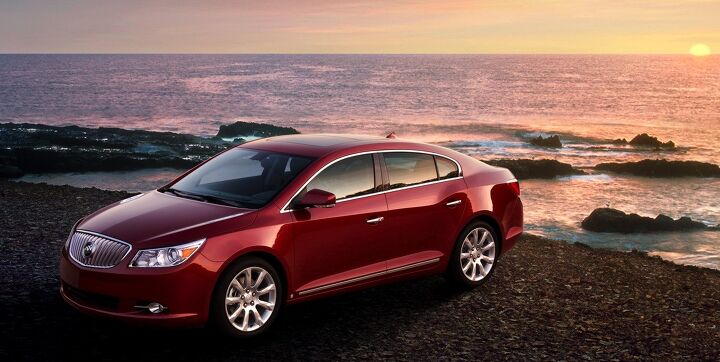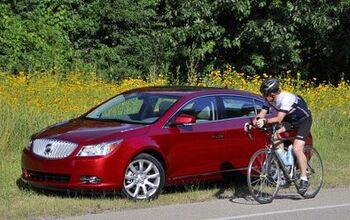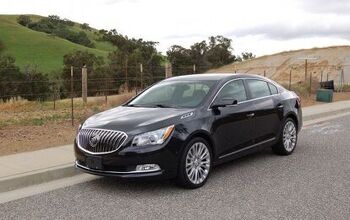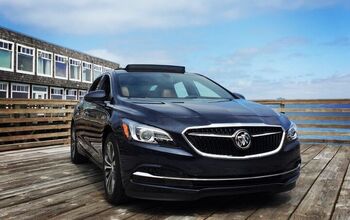Review: 2010 Buick LaCrosse
“The company’s survival depends on the success of this car.” Though regularly trotted out, this statement is almost always BS (not to be confused with the Bertel kind). Typically when the hyped new car fails, the company seems to somehow scrape by. But the 2010 LaCrosse might just warrant such an extreme statement, at least with regard to Buick’s survival outside China. GM has been on a brand-killing spree lately, and this car will test whether or not Buick is beyond saving in the U.S. The Enclave has proved that American car buyers are open to a Buick crossover. But a Buick sedan, with more baggage to overcome, poses a greater challenge. So, does the new Buick LaCrosse–and the brand that’s banking on it–deserve to succeed?
My initial impressions of the new LaCrosse’s exterior styling, during NAIAS press days last January, were mixed. The traditional Buick “sweep spear” seemed forced on the ultramodern, cab forward proportions. Ideally the line on the front fender would be an inch or so lower, which would require that the fender itself be lower. Out in the real world, the new LaCrosse stands out–in a good way–with a premium and somewhat futuristic appearance. The proportions and dimensions are similar to those of the new TL, but the Buick is far more attractive than Acura’s brick. Is that faint praise? Try this: one will mistake it for a Chevrolet. Because of its large wheels and stocky build, the LaCrosse appears smaller than it actually is–which is nearly full-size. In today’s climate this probably helps, more than it hurts.
The LaCrosse’s interior is GM’s best yet, dominated by flowing curves that encapsulate the driver and front passenger. Beyond the original and attractive design, I was especially impressed by the way real stitching was incorporated into the molded instrument panel, for the appearance of an upholstered IP at a much lower cost.
But there’s the rub: Buick’s interior ambition is lofty, but the bean-counter’s hand is still all over the execution. In sunlight, the materials aren’t as convincing and various small details (such as the sliding cover of the console’s storage compartment) seem less finished than they should be. I drove an HS 250 earlier the same day, and the LaCrosse’s interior materials simply can’t match one of the cheapest sedans Lexus makes. Still, it is a step up from the Malibu, and better than that of any Ford or Chrysler. GM is very close to getting this bit right.
The front seats are comfortable, and even provide a modicum of lateral support. The rear seat, a bit low to the floor in the traditional GM manner, and offers plenty of room for legs, but not so much for shoulders. It still remains to be seen whether GM can offer an Epsilon-based car that feels roomy. The specs are almost competitive, but subjectively the cabin fails to feel expansive. Credit the high beltline, prominent console, and organic curves that are otherwise so appealing. The trunk would have been narrow anyway, but the decision to fully encapsulated the door hinges further constricts the space.
Extraordinarily broad A-pillars (why?) and a high cowl dominate the view forward from the driver’s seat. Visibility in turns ranks among the worst I’ve experienced in a sedan. I found myself leaning forward to check that nothing was in the resulting front quarter blind spot. The transmission can be manually shifted, but the shifter needs to be repositioned farther from the driver for optimal comfort. The view rearward between the also thick rear pillars and over the high trunk…good thing there’s a rearview camera.
I spent most of my time in the LaCrosse CXL AWD. In case anyone has been wondering how well a 3.0-liter V6 engine, even one with 252 horsepower, can motivate 4,200 pounds of sedan…not so well. Especially at low speeds, acceleration verges on sluggish. Even in typical driving, with shifts occurring between 2,500 and 3,000 rpm, the engine sounds like it’s working more than a luxury car engine ought to. Things could be worse: the engine could sound as rough as it does overworked.
I briefly drove the top-of-the-line LaCrosse CXS, and that car’s 280-horsepower 3.6-liter V6 feels much more energetic and sounds considerably less strained. On the other hand, the 3.6 too easily provokes both wheelspin and torque steer. Why isn’t all-wheel-drive available with the 3.6? Working with the same basic transmission, Ford now offers a twin-turbo 3.5-liter with AWD.
GM probably specified a 3.0-liter as the LaCrosse’s principal engine for fuel economy reasons. Or perhaps they figured that a 3.0-liter with the same peak horsepower as their previous generation 3.6 would provide the same driving experience as that 3.6. Either way, the 3.0-liter engine fails. In normal driving, it feels like a 3.0, not a 3.6. The 252 horses dwell at 6,900 rpm, where few Buick drivers will dare to tread. Peak torque, more constrained by displacement, is only 215 pound-feet. But there’s always fuel economy, right? Wrong. The EPA ratings of 16 city and 25 highway are no better than those of more powerful competitors. Even the Lincoln MKS, with a 355-horsepower turbo six and even more poundage, does a bit better. So what’s the point of the 3.0, when it’s both less powerful and less efficient?
The new LaCrosse being a Buick, sloppy handling might be expected. In truth, the CXL AWD feels composed and stable, with well-controlled body motions, an acceptable amount of lean in turns, and a minimal amount of understeer. The all-wheel-drive system includes the active rear differential pioneered by the Saab 9-3 Turbo X. This differential counteracts understeer by routing torque to the outside wheel in turns. Throttle-induced oversteer is theoretically possible, but this would require more twist than the V6 can deliver (or possibly an unpaved road surface.) Even with the trick differential and nicely-weighted steering, the LaCrosse doesn’t feel agile, but then nothing in this class does.
The ride isn’t quite as creamy as that of a Lexus, with some clomping over bumps but no untoward jitters. Aside from the engine under acceleration, noise levels are very low. In fact, even when the engine isn’t particularly loud, the absence of other noise makes it sound louder than it is. This solid feel and quietness partly justify why the new LaCrosse weighs so much. Stress the partly. A Lexus ES is also quiet inside, and weighs nearly a quarter-ton less than the front-wheel-drive LaCrosse. Even the bloated Acura TL weighs a couple hundred pounds less. Check the specs of any new GM product, and you’ll find that the company has a serious mass control problem. Too little room in the budget for ultra-high-strength steel?
So, what’s the verdict? The new Buick LaCrosse turns heads and is a viable alternative to the similarly sized Acura TL and Lexus ES, for less money. If Buick weren’t struggling with a load of baggage, this car would succeed. As it is, anyone looking for an excuse not to buy a Buick can still find one in the sluggish 3.0-liter, the EPA figures, or the driving position. The LaCrosse may be a step in the right direction, but Buick is still on a thousand-mile journey.
The last weakness isn’t fixable without a major redesign. But giving the 3.0 the heave-ho would make the largest difference, and it’s something GM could do, and should do, right away. Forget the 182-horspower four-cylinder that’s on the way–do they want to kill another brand? The 3.6 should be the base engine. For the up-level engine, offer a turbo 3.6 with all-wheel-drive. This shouldn’t pose too much of a challenge. GM was rumored to have a turbo 3.6 in development nearly a decade ago, and Ford has proven that the transmission can handle the resulting torque. More than anything else, Buick needs a sedan people feel compelled to consider. A LaCrosse with enough horsepower to fully exploit the fine chassis–a SHO-matching 365 for example–would be compelling.
Michael Karesh operates TrueDelta.com, a provider of car reliability and real-world gas mileage information
Michael Karesh lives in West Bloomfield, Michigan, with his wife and three children. In 2003 he received a Ph.D. from the University of Chicago. While in Chicago he worked at the National Opinion Research Center, a leader in the field of survey research. For his doctoral thesis, he spent a year-and-a-half inside an automaker studying how and how well it understood consumers when developing new products. While pursuing the degree he taught consumer behavior and product development at Oakland University. Since 1999, he has contributed auto reviews to Epinions, where he is currently one of two people in charge of the autos section. Since earning the degree he has continued to care for his children (school, gymnastics, tae-kwan-do...) and write reviews for Epinions and, more recently, The Truth About Cars while developing TrueDelta, a vehicle reliability and price comparison site.
More by Michael Karesh
Latest Car Reviews
Read moreLatest Product Reviews
Read moreRecent Comments
- El scotto err not be an EV but to own an EV; too much training this week along the likes of what kind of tree would be if you were a tree? Sorry. Bring back the edit function.
- The Oracle Geesh, Stellantis can’t even perform the upkeep on that relic of a plant. Sad.
- The Oracle I see Tesla introducing disruptive charging technology within 3 years.
- The Oracle I can see into the future and I see fisticuffs and profanity-laced tirades coming to charging locations near ya’ll.
- El scotto Will ascots be discussed at the HOA meetings? Or Purdey shotguns?





































Comments
Join the conversation
3400 lbs and 180 HP . . . the Toytoa Venza comes to mind, though that's similar platfrom with a different purpose body. . . . I have to agree with Karesh, a 180HP four in a car this heavy doesn't sound "luxury" or "near luxury" or whatever Buick means thease days. Design-wise, I really love this vehicle, save two elements: 1. Someone mentioned in a review on antoher website that the radio buttons resemble a robotic puppy face. When I look at it that's all I can see now. Freaky. 2. The headlights, nicely shaped, remind me of the Chevy Cruze. All-in-all, the exterior reminds me a bit of the Infiniti Q, another handsome, but heavy car.
Based on looks alone, this is the first Buick I'd ever consider buying. Perhaps I'll look at one in a few years when I go to trade in my 3-series (with new kids, I'm thinking of 'trading-down' to something roomier and with an automatic, like an Acura).